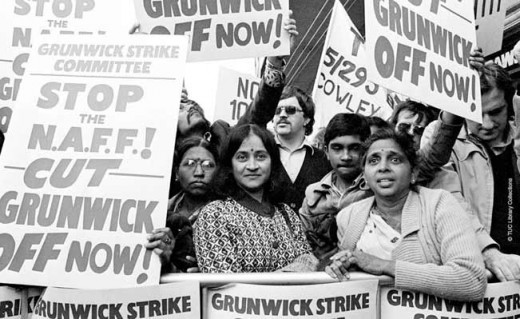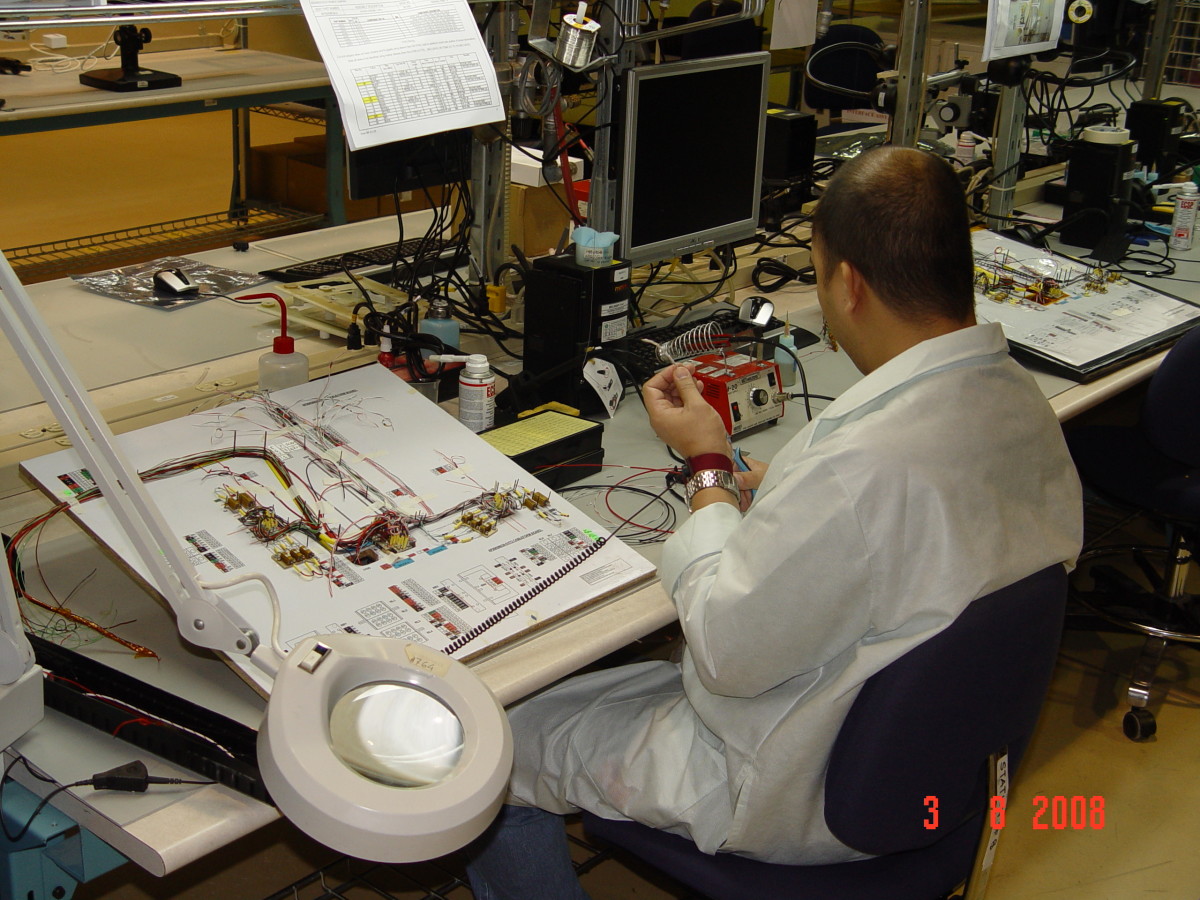- HubPages»
- Books, Literature, and Writing»
- Books & Novels»
- Nonfiction
from A Squandered Life / Grunwick '77

.....the confrontations more and more ugly as the police protected Grunwick's right to employ people under whatever conditions they chose.
Our commitment to anti-racism peaked with the advent of the strike by 137 Asian women at the Grunwick photo development plant in Cricklewood, north west London. The women, led by the indefatigable Mrs Desai, came out on strike as a last resort in trying to overcome third world sweat shop pay and working conditions. They were all immediately sacked and a new load of desperate Asian women brought in to replace them. But Mrs Desai and her colleagues persevered, day after day, week after week, month after month, until the entire Labour movement became aware of them. Like many TU branches around the country, ours sent funds and messages of support, but these escalated into boycotting and picketing local photographic firms who used the Grunwick service and, eventually, into on location presence with the women for designated national days of support.
The national days of support became bigger and bigger and the confrontations more and more ugly as the police protected Grunwick's right to employ people under whatever conditions they chose. By this time the terrified strike breakers, unable to see how they were undermining themselves, were being bussed in with helmeted, baton wielding, padded coppers making way. This was made more and more difficult as the supporting throngs grew and were even joined by the mighty Miners who came south to show solidarity. All this under a Labour government and an ascendant TUC, both of which preferred to look the other way and pretend nothing was happening.
Helmeted and padded police horses were brought in to up the ante for all concerned. A ritual established itself whereby Mrs Desai and her colleagues would be joined at the gates in the early morning by incoming trade unionists. All would be peacefully milling around chatting as the police and the press gathered opposite. As the time for the busses to arrive drew near, tension would mount and the police would approach in wedge formation, with the press snapping away at anything which looked remotely violent. Initially it would be just a matter of body weight as both sides tried to achieve their objectives. The police, with horses, would inevitably open a way for the buses to get through as pickets shouted and gestured. Once the buses were through, the police would withdraw again and the pickets would again mill about in front of the gates, chatting, and the press would scarper off for extended lunch breaks.
As the confrontation matured and bad feeling between police and strikers grew worse, the disappearance of the press became an important focal point. On several occasions, once the press had cleared off, the police suddenly grouped for full-on baton and shield charges and came at us with intent to maim and injure. There would be blood and screaming and mayhem and people dragged off for further beatings in police vans.

Trial by School Boy
I was arrested twice, at random, for nothing more than just being there. The first time I was grabbed from behind as I was talking to people on the line long after the strike breakers had already gone in. I was dragged away before anybody could react in any way, and stuffed into a police bus. The bus was full of similarly bemused people who had apparently been grabbed in the same random way. We were “processed” in some nearby station, which meant being charged with “obstruction” and “threatening behaviour”.
After several hours of “processing” we were released with court appearance dates. Outside, on the back steps, people like Harriet Harmen and Patricia Hewitt, both of whom years later became Labour MPs (in the case of the latter, a profoundly disappointing one). They were dutifully keeping a register of all arrested union members and assuring us that our legal costs would be covered by the Joint Strike Committee.
Back in Cambridge I had apparently achieved new levels of respect among my erstwhile lefty colleagues at the Tech. They all supported the women at Grunwicks, but couldn't, of course, spare the time ever physically to be on hand for the mass pickets. A feature of hard lefties at the college was to attend many meetings, speak loudly and aggressively, then repair to the pub.
This was my first experience of the splendidly ornate stupidity of the British legal system. Although we spoke briefly on the phone, I didn't actually meet my solicitor until the morning of my court appearance. As discussed, I'd asked a couple of witnesses to show up to testify on my behalf. In a hurried conversation we thrashed out the order of events to be presented in court. Then, with minutes to go before we went in, the “barrister” materialised. It was this blonde rosey cheeked chappie, not the solicitor who had at least conversed with me on two occasions, who was to be my spokesperson. This was because the rosey cheeked chappie, complete with a silly wig balanced on top of his head, had been to a better class of private school and was now a member of the charmed circle of similarly educated and be-wigged people allowed to present cases in front of correspondingly educated and be-wigged judges.
On the strength of these few minutes of hurried briefing, the cheeky chappie decided it would be best not to call my witnesses as “this would only antagonise the judge”. I and my assembled witnesses were astonished. Nevertheless we and my solicitous solicitor deferred to the barrister's superior understanding of the inner workings of the law.
Twenty minutes later I was found guilty and had a record.
I was incensed and when my soothing solicitor asked if I wanted to appeal I said, “Of course I fucking do...”
Several weeks later this farce was repeated almost verbatim until the rosey barrister popped up again and yet again suggested we should drop the witnesses in order not to antagonise the judge. I put my foot down and point blank refused. He more or less said, “Well, be it on your head,” and we all trooped in for round two.
In round one, the prosecution's case had consisted of their private school boy drawing out the policeman's uncorroborated story and then cross-examining me by saying: “I put it to you”, and then listing a whole range of infamies of which I stood accused, including what I probably had in my mind at the time. I found myself dutifully responding to each “put it to you” with a “no” or a “that's not true” or “of course not”. In the weeks that followed, as I flushed with the ignominy of the re-lived moments, I reasoned that this response to the point by point “put it to you's” had the effect of making me seem (and feel) guilty. For round two I resolved not to respond in the same way.
The policeman was called and his story trotted out again. My witnesses were called (one of whom was a lawyer at a community law practice) and an entirely different story was presented. I was called and when it came time for the weasel-faced be-wigged school boy to “put it to you”, I remained silent. “I put it to you that you did this” and “I put it to you that you intended that” and “I put it to you that you were thinking the other”, but the natural rhythm of his presentation fell apart without the required punctuation of my denials. In the end he couldn't think of anything else to put to me and fell silent, looking at me expectantly. I looked at him. He looked at the judge. I looked at the judge. The judge looked at me. I said to the judge, “What's the question?”
There was a hushed pause. Then the much more profoundly be-wigged judge suddenly harrumphed and told the school boy to get on with it and wind up. The school boy blushed and stammered and wound up.
I won my appeal and was even congratulated by my own be-wigged school boy.

The second time I was arrested I wasn't so lucky. There were no civilian witnesses as, at a very quiet time of the day, I walked past a police bus on my own. A copper simply reached out and grabbed me and started stuffing me into the bus. Same old routine but this time I heard my copper discussing my “arrest” with another copper who hadn't been there but had only just come on to the bus. They were comparing their little notepads and agreeing statements before we arrived at the processing station. This time I was on my own in the court with no witnesses. All I had was a “character reference” from Geoffrey, the CPF CEO which, I thought, was both touching and impressive. He even referred to himself as “a former man of the cloth”, which was news to me but made him sound even more credible.
However the prosecution trotted out their arresting officer and his sworn and astonishingly corroborative witness who both told the same absolute pack of lies. I was done for the standard “obstruction” and “threatening behaviour” and fined £60, a lot of money in those days, and had a bona fide record. Happily, my ASTMS Branch stumped up for the fine and gave me a round of applause to boot.
Mrs Desai and her colleagues were not so lucky. Having stood their ground from 20th August 1976 to 14th July 1978, the whole thing, without the support of cowardly Labour and TU top brass, gradually lost headway and disappeared into the mists of time.
But years and years later I was still being stopped by the Met in the middle of London whilst driving my van and being addressed by my first name by coppers before they'd even seen my driving license. Occasionally, as I was handing them my license, they might look at me and add, “So, you've been in trouble with us before.”
© 2013 Deacon Martin








